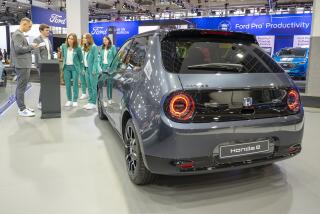Toyota Profit Falls on Cost of Research
- Share via
Toyota Motor Corp.’s fiscal first-quarter profit dropped 7% as soaring global research and expansion costs and a strong yen offset higher sales.
But the world’s second-largest automaker said Wednesday that it expected profit to pick up in the remainder of its 2006 fiscal year as it begins rolling out new products in most markets.
Toyota also announced that it wanted gas-electric powered hybrids to make up 25% of its U.S. passenger vehicle sales by early next decade.
Toyota’s U.S. president, Jim Press, said Wednesday that to meet that goal the company planned to add 10 gas-electric hybrid vehicles to its lineup. “To us, it’s not a passing phase but a vital technology for the 21st century,” he said at an automotive conference in Michigan.
Previously, Press said that Toyota soon would be able to offer hybrid versions of any vehicle it made if there was enough public demand.
The company already sells the popular, gas-stingy Prius sedan, and has launched two sport utility hybrids, with two more passenger car hybrids due next year.
In addition, for the U.S., new gasoline-powered Toyota vehicles will include a redesigned Lexus IS sport coupe and a new SUV, the FJ Cruiser, from the Toyota division.
Toyota is investing in the future “to become the No. 1 automaker,” said Koji Endo, an auto industry analyst for Credit Suisse First Boston.
Toyota said profit for the April-June quarter totaled 266.8 billion yen ($2.4 billion), down from 286.6 billion yen the previous year. Revenue for the period rose 11% to 4.98 trillion yen ($44.7 billion) from 4.5 trillion yen a year earlier.
All told, Toyota sold 1.95 million vehicles worldwide during its first quarter, including 606,834 in the U.S. -- its largest market. While global sales increased 9% for Toyota during the three months, its U.S. sales rose 12.4%.
For the calendar year through July, the company’s U.S. sales have increased 10.4%, outpacing all but one competing automaker: Nissan Motor Co., whose U.S. sales soared 14.8% through July.
“We believe we have been able to continue expanding [U.S.] sales by strategically controlling marketing costs such as incentives,” said Takashi Hata, a Toyota Motor managing officer.
Meantime, U.S. automakers, despite booming summer sales driven by their popular “employee discount” pricing programs, are trailing Toyota, Nissan, Hyundai Motor Co. and several smaller Asian import brands in sales growth.
Toyota’s U.S. performance has been boosted by the popularity of the youth-oriented Scion line, the Prius, a redesigned Avalon sedan and Sienna minivan and several of its Lexus luxury vehicles.
The company expects worldwide vehicle sales to hit 7.97 million units for the fiscal year ending next March 31. That would be a nearly 8% increase from the 7.4 million vehicles Toyota sold in its 2005 fiscal year and would move it closer to overtaking General Motors Corp. as the world’s largest automaker. GM has been selling about 8 million vehicles a year globally.
Meanwhile, Toyota’s profit has been hurt by the yen-dollar exchange rate, which hurts Japan’s exporters by cutting into the value of overseas sales.
Toyota said exchange-rate losses pared 10 billion yen ($90 million) from its first-quarter profit.
Increased research and expansion expenses cut an additional 87 billion yen ($781 million) from earnings. In the U.S., Toyota’s expansion includes an $850-million full-size truck plant in San Antonio, which is expected to open early next year.
Toyota shares closed at $76.36 on Wednesday, down 59 cents, in U.S. trading.
Times wire services were used in compiling this report.
More to Read
Inside the business of entertainment
The Wide Shot brings you news, analysis and insights on everything from streaming wars to production — and what it all means for the future.
You may occasionally receive promotional content from the Los Angeles Times.










